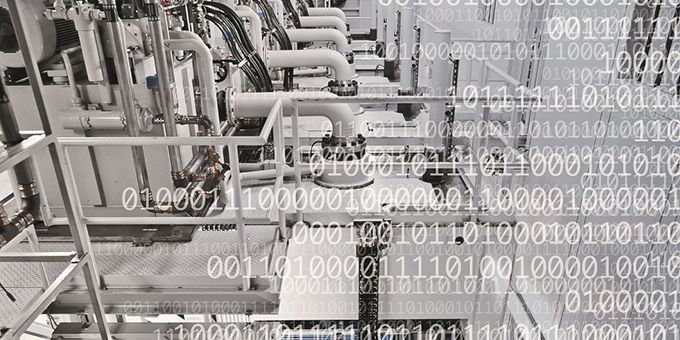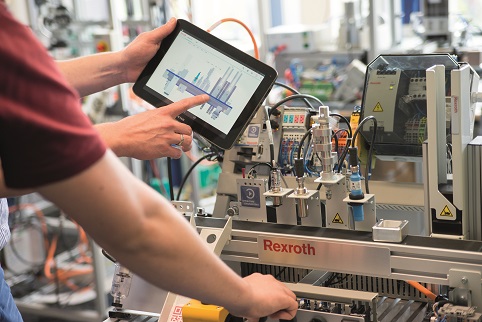Taking a predictive approach to maintenance is key to maximising uptime, and with Industry 4.0 transforming the manufacturing landscape, now is the time for design engineers to look to digital solutions to reduce machine downtime and ensure consistent levels of efficiency.
 Maintenance in the Digital World
Maintenance in the Digital World

Contributed by | Bosch Rexroth
For manufacturers operating in today’s highly competitive global marketplace, unforeseen downtime presents a significant challenge, often leading to higher costs, missed order deadlines and even reputational issues. As Richard Chamberlain of Bosch Rexroth discusses, taking a predictive approach to maintenance is key to maximising uptime, and with Industry 4.0 transforming the manufacturing landscape, now is the time for design engineers to look to digital solutions to reduce machine downtime and ensure consistent levels of efficiency.
With maintenance-related downtime having long presented challenges for manufacturers, the process of predictive maintenance is becoming a useful tool in reducing the risk of expensive facility downtime. Based on condition monitoring, essential components are fitted with sensors, each programmed with upper and lower limit values for the sensor signals and alarms based on the operating instructions and experience of past values. In practice, this delivers insights into machine health and enables manufacturers to make better informed decisions around when to replace the components of vital machinery – and avoid complete machine failure.

With the arrival of Industry 4.0, the latest technologies are moving this function of equipment maintenance to a truly anticipatory approach. Utilising the data harnessed through strategically-placed sensors, new digital solutions – which can be easily incorporated on the factory floor – generate far more reliable predictions and recommendations based on machine health and knowledge. Interpreting real-time data, the digital solutions facilitate the implementation of anticipatory management measures, ultimately reducing downtime.
With that in mind, simply installing the means through which big data can be collected is not enough; design engineers must combine the power of digital solutions with that of human intelligence.
Placing data at the heart
Just as when looking at the far-reaching possibilities of Industry 4.0 as a whole, a digital movement can’t achieve results on its own. Essentially, it must be combined with intelligence – human intelligence. In practice, to render the data harnessed through a network of sensors useful, it must be visualised, evaluated and acted upon.
One way of doing this is through ActiveCockpit, a tool developed by Bosch Rexroth which makes it simple to collect, process and visualise the relevant data of a manufacturing facility. By translating complex data collected from vital machinery via strategically-placed sensors and presenting it in user-friendly visuals in real-time, faster and more accurate decision making can happen on the shop floor. Once installed, this means systems and processes can be adjusted in-line with findings to achieve tangible results, immediately.
To make that happen, algorithms and mathematical models are constantly at play behind the scenes. These are not only written to make the best use of big data, but are combined with huge computing power to enable software to use the data for itself, connecting patterns, pathways and predictions to be visualised for the use of people on the factory floor. Once acted upon, changes can be evaluated to facilitate continuous improvement through machine learning.
Predictive maintenance in the era of Industry 4.0
So as technology evolves to capitalise on the presence of big data and support manufacturers in their efforts to maintain maximum competitiveness, the primary drivers for manufacturers to implement these Industry 4.0 developments remain the same: to reduce costs, elevate levels of quality and increase output.
On the factory floor – where components are fully networked and connected to give greater control and visibility of their performance – that can translate into a health index programme for predictive maintenance. In essence, that allows components to be replaced at the most optimal time, taking into account factors such as asset health, as well as the impact on the broader connected factory, so a smooth and efficient flow of operations is always maintained. One key advantage of this approach is the accuracy of fault finding and prediction capability. Statistically, in a given case, detecting a fault by chance carries a probability of just 13%, a figure which is increased to 43% with expert human monitoring. Couple that with machine learning, however, and fault detection accelerates to 95%.
The ODiN system from Rexroth, which incorprates self-learning algorithms and predictive maintenance software, is a practical solution which is able to deliver a health index of connected machinery. Providing an indication of machine condition, manufacturers are equipped with the insights they need to maintain consistant levels of productivity and reduce the occurrence of unexpected downtime.
Taking a big picture approach
To maximise the impact of these digital solutions, it is critical for design engineers to precisely plan how Industry 4.0 is to be incorporated into their facility. Here, whether a facility chooses to take an incremental approach or opts for a complete digital overhaul, it is important to remember that digital technologies are highly scalable and can match even the most complex of production environments.
Even legacy machinery, which is perhaps most prone to high component wear or unexpected breakdowns, can be brought in line with the digital future by adapting equipment to accommodate intelligent sensors, controls and drives to form the basis for comprehensive predictive analysis. Once connected to an end-to-end system, the process of predictive maintenance through machine learning is perfectly aided.
Working with a supplier such as Bosch Rexroth makes such transitions easier, supporting each phase of the digital transformation, from planning right through to implementation. So as data harnessing and visualisation drives software to become smarter and factories more intelligent, it also facilitates a truly proactive approach to maintenance, helping operations to run more efficiently to deliver more consistent levels of quality and output – ultimately maximising profitability and competitiveness in today’s ever-changing global market.
For further information, please visit https://www.boschrexroth.com/en/gb/trends-and-topics/industry-4-0/industry-4-0
The content & opinions in this article are the author’s and do not necessarily represent the views of ManufacturingTomorrow
Comments (0)
This post does not have any comments. Be the first to leave a comment below.
Featured Product

